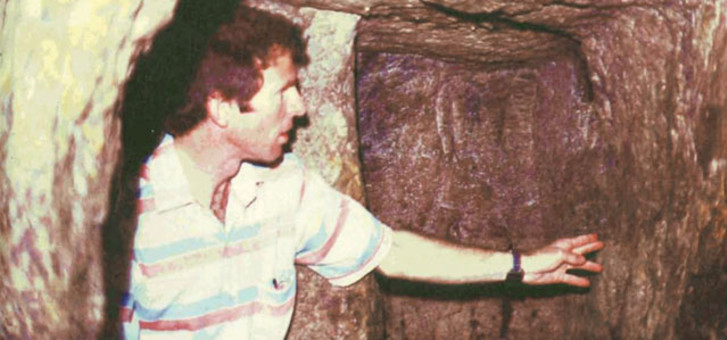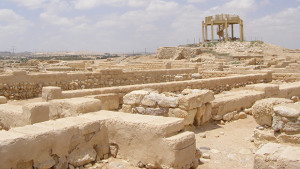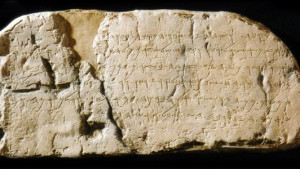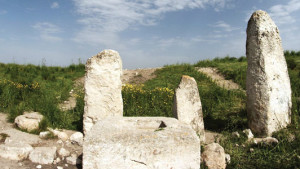Hezekiah's Tunnel runs from the Srping Gihon in the Kedron Valley of Jerusalem to the Pool of Siloam where Jesus Christ sent the blind man to wash his eyes and receive his sight (John 9:7). It winds in an S shape 533 metres long, bringing water from the spring to a point which was once inside the old city of David. It was cut by Hezekiah's workmen to deny water to the expected Assyrian army and to guarantee water supply to the residents of Jerusalem during the siege. "Hezekiah also stopped the water outlet of Upper Gihon and brought the water by tunnel to the west side of the City of David" (2 Chronicles 32:30).
Every year our Diggings group has the opportunity of wading through this tunnel. Usually about half the group take one look at the gloomy entrance and decide to walk down the road and meet us at the Pool of Siloam, but usually those who take the plunge emerge saying it is one of the highlights of the tour. Sure, the water is cold and in places comes up to our hips. There is no artificial lighting but we can use torches to light the way, and we can feel that we are being part of ancient history.
Mind you, it was not always that easy to go through this tunnel. Charles Warren crawled through it when it was almost completely blocked by debris, and in places there was not much space between the surface of the water and the roof. He describes his experience in these words. "We are now crawling on all fours.. . and we suddenly awoke to the fact that the waters were rising. [The word Gihon in Hebrew means 'gushing' and is so named because the water comes out from the spring in spasmodic bursts]. At 850 feet (257 metres) from the entrance the height of the channel was reduced to 1 foot 10 inches (55cm) and here our troules began. The water was running with great violence 1 foot in height (30cm) and we, crawling full length, were up to our necks in it...One hand necessarily wet and dirty, the other holding a-pencil, compaHs and field book; the candle for the most part in my mouth.. . The passage being only 1 foot 4 inches high (40cm), we had some difficulty in twisting our necks round properly. When observing, my mouth was under water.'"
The whole way through took him 4 hours. Now we walk through comfortably in about 40 minutes.
There can be no doubt that the tunnel that bear's Hezekiah's name is indeed the tunnel that his workmen dug because there was an inscription on the wall of the tunnel near the Pool of Siloam which identified it, To say that it was dug 2,700 years ago labels it as a remarkable feat of engineering. It would be an amzing accomplishment if it went in a straight line but it winds in a series of curces and yet the workers, starting from both ends, met in the middle. The question that has occupied scholars is, "How did they do it?" Both the pick-marks on the walls of the tunnel, and the inscription at the end, prove that the men did inded start diffing from both ends and met in the middle, but the question was, why did they take that route? Why didn't they go in a straight line which would have only measured 318 metres,obviously easierroute than an S bend? At first it was suggested that they followed the line of least resistance by digging through soft rock wherever they found it. This was a plausible idea until someone tested the rock and found that although there are different types of rock under the city, the route followed by the tunnel was not always through the softest rock. It was then suggested that it followed that route to avoid interfering with the sacred tombs that were above, but when some surveying was done it was found that there were no tombs directly above a possible straight line, and in any case, the depth of the tunnel was well below the level of the tombs. Up to that point it was mostly the archaeologists who were trying to solve the problem but in 1994, rather logically, an Israeli geologist by the name of Dan Gill got into the act. In the December 1994 edition of Diggings we reported: "Dan identifies two types of rock in the tunnel area-limestone and dolomite. The former is fairly soft and porous, the latter comparatively hard. It is rather interesting that this limestone consists of about 30% fragments of fossil shells and some coral, which means that Jerusalem which is now about 700 metres above sea level, must have been beneath the ocean at some time in the past."
"This combination of soft limestone and hard dolomite is not uncommon in the limestone hills in Israel and it gives rise to many water seepage systems of caves, shafts and natural tunnels. As the water seeps through the porous limestone it wears a course for itself, but when the seeping water hits a layer of dolomite it flattens out or changes course. Dan claims that this is what happened to much of the water that seeped through the rock. It carved a tunnel for itself and it is the course of this tunnel that Hezekiah's engineers followed."

It was all very plausible and found ready acceptance in the academic world, but in an article by Steven Lancaster of the Jerusalem University College and G.A.Long of Wheaton College U.S.A in the August 1999 edition of the Bulletin of the American Schools of Oriental Research, an exhaustive analysis of the evidence has been presented. A recent survey found that though the workmen did seem to follow what seemed to be a soft rift in the rock most of the way, the whole tunnel could not be explained by that theory, especially near the centre of the tunnel where the two ends meet.
It was previously thought that the men had only changed direction once when they got near centre and heard the sound of picks from the opposite end workers, but the present meticulous survey has demonstrated that the workers from the northern end changed direction or even deviated some five times and the workers from the southern end deviated three times. All of this reveals that this final phase of work must have developed into an intense drama.
Time was not on the workmen's side. Samaria was besieged and captured in 722 BC. The horrors of that defeat must have been very vivid in the minds of the people of Jerusalem. Assyrian reliefs depicted how the Assyrians treated the cities that resisted them. Leading men were beheaded, impaled on sharp poles fixed into the ground, or skinned alive, and it did not take too many guesses to imagine what happened to the women and girls. Then followed the long and arduous march into exile, removal to a foreign land.
Now, twenty years later, the Assyrian armies were once more on the march, and preparations for the defence of Jerusalem were urgent, and here were the workmen, desperately trying to complete their assignment before the Assyrian army arrived. The work was almost completed but here was this tense drama of meeting each other deep beneath the city of David. The Siloam inscription reads, "This is the story of the piercing through. While the stone cutters were swinging their axes, each towards his fellow, there was heard the voice of a man calling to his fellow, for there was a crevice on the right ... and on the day of the piercing through, the stone cutters struck through each to meet his fellow, axe against axe."
The surveyors estimated that the workmen would only be able to cut through about 1.8 metres of tunnel a day. Only one man could do the pick work against the unfinished face, and the baskets of stone chips would have to be passed back along the tunnel by chain gangs of labourers. It would all take time and under the threat of the expected invasion every minute would count.
At one point near the centre they looked like passing each other l7 metres apart. Without an accurate knowledge of how near they were to centre they could have gone well past each other without knowing it. What made them change direction is still not known. It would have been too far apart to hear each other through the solid rock. Even after changing direction they were still headed in directions that would have by-passed each other by six metres, but maybe by then they could hear the dull thud of pick against rock from the opposite team.
Once more a change of direction was made until they were close enough to hear, perhaps through a crack in the rock, "the voice of a man calling to his fellow", and then there was the joyous moment "when the stone cutters struck through each to meet his fellow, axe against axe."
Wading through Hezekiah's Tunnel will never be the same again. In the past, the objective of most tourists is to get out the other end as fast as they can, but in future, as we near the centre, we will look for the deviations in direction noted by the scholars, and, relive the drama of those tense moments of history.
The dreaded Assyrians finally arrived and haughtily demanded the surrender of the city, but they never conquered Jerusalem. How much the tunnel contributed to the successful defence of the city will never be known.
According to the Bible record the main factor was divine intervention. "It came to pass on a certain night that the angel of the Lord went out and killed in the camp of the Assyrians one hundred and eighty five thousand; and when people arose early in the morning, there were the corpses-all dead. So Sennacherib king of Assyria departed" (2 Kings 19:35,36)
But at least King Hezekiah had done his best to prepare for the siege. "He made a pool and a tunnel and brought water into the city." (2 Kings 20:20).






